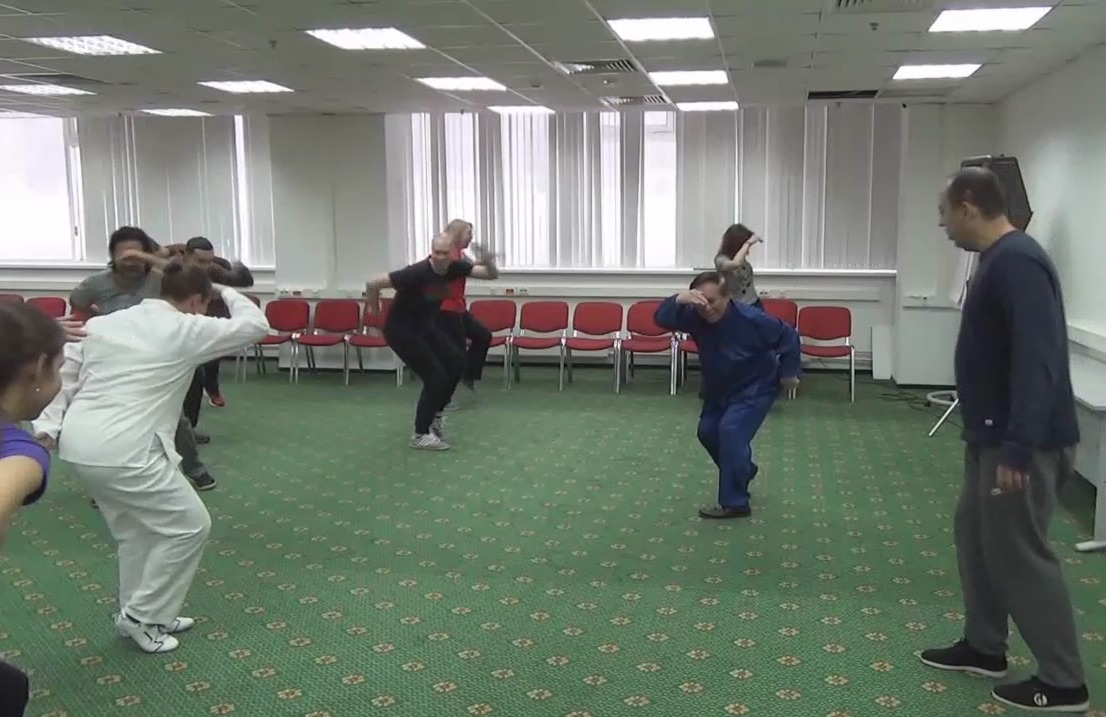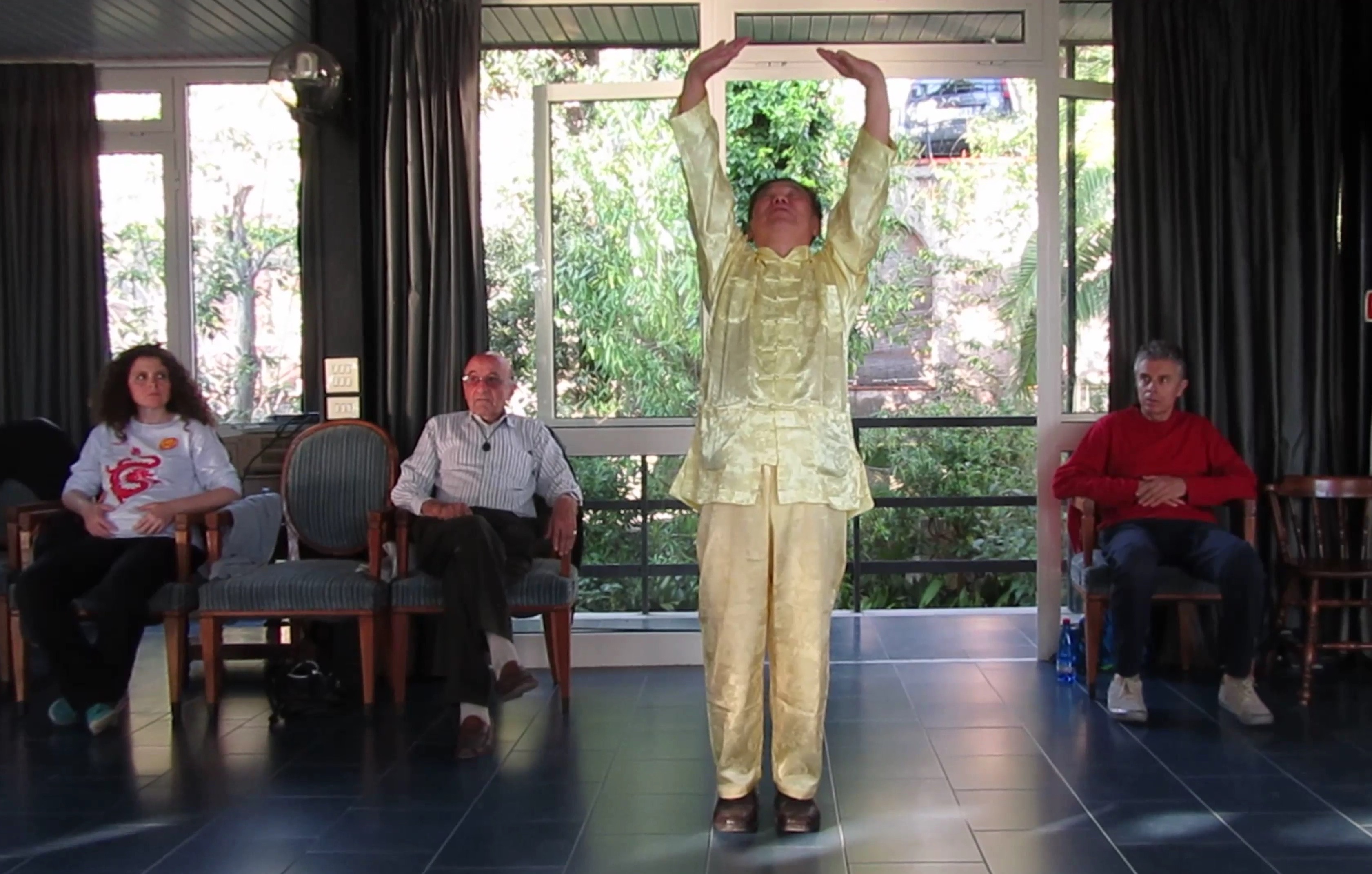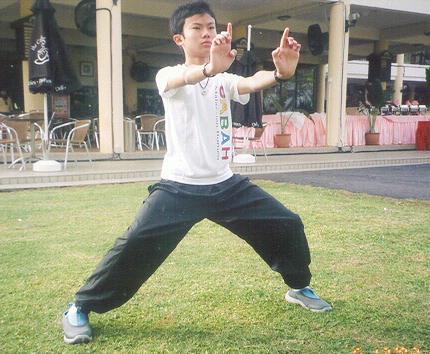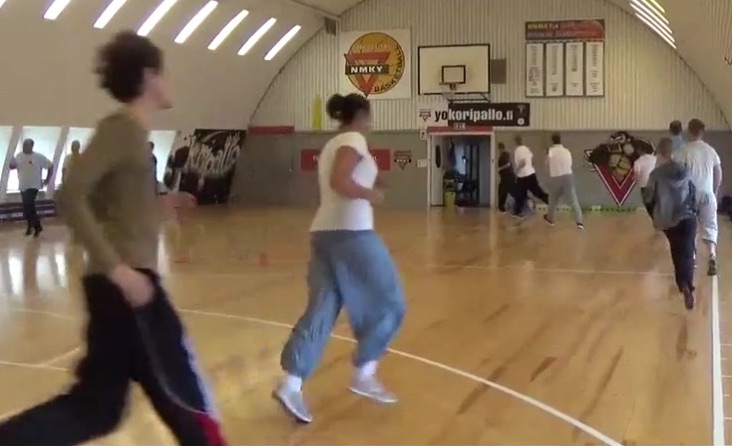SELECTION OF QUESTIONS AND ANSWERS
JULY 2019 PART 1

Monkey Play of Five-Animal Play
Question 1
What qigong exercises should I practice to overcome feeling of fear or anxiety?
— Thomas, Canada
Answer
Many people may not realize that it is not what qigong (chi kung) exercises one should practice, but it is the skills of practicing the qigong exercises that is important.
Many people today have feeling of fear or anxiety. If it were true that certain qigong exercises would overcome feeling of fear or anxiety, they would have overcome it long ago.
The feeling of fear is related to the kidney system. Qigong exercises like Nourishing Kidneys, Bear Walk and the Bear Play of the Five-Animal Play are helpful. The feeling of anxiety is related to the spleen system. Qigong exercises like Merry-Go-Round, Plucking Stars and the Monkey Play of the Five-Animal Play are helpful.
However, it is not the qigong techniques that are important, it is the skills that make the techniques qigong and not gentle physical exercise. In other words, exercises like Nourishing Kidneys, Bear Walk, Bear Play, Merry-Go-Round, Plucking Stars and Monkey Play can be practiced as qigong or as gentle physical exercise.
Unfortunately these exercises are generally practiced as gentle physical exercise, usually without the practitioners knowing. In other words, the practitioners do not know they practice gentle physical exercise, they say, wrongly, that they practice qigong. Hence, these qigong techniques practiced as gentle physical exercise do not overcome the feeling of fear or anxiety.
If people want to overcome the feeling of fear or anxiety, or derive other qigong benefits like having good health, vitality and longevity, they must practice the exercises as qigong. A good analogy is Taijiquan. Many people say, wrongly, that they practice Taijiquan, or Taiji for short. But actually they only practice external Taijiquan forms, and not Taijiquan.
To practice qigong exercises as qigong, one must learn from a master who is willing to teach genuine qigong. Genuine qigong is rare today.
Question 2
What are the Eight Pieces of Brocade and how they became to be?
— Sifu Angel Perez, Shaolin Wahnam Puerto Rico
Answer
The Eight Pieces of Brocade are the first eight exercises of the Eighteen Lohan Hands, namely Lifting the Sky, Shooting Arrows, Turning Cosmos, Plucking Stars, Thrust Punch, Merry-Go-Round, Carrying the Moon and Nourishing Kidneys.
It has been known as Taoist Chi Kung, and it is found exactly but without the breathing methods in, surprisingly, Baden Powell's "Scouting for Boys", and is one of the requirements for the basic Tenderfoot Test in scouting.
There was an interesting story of my composing the ordering of the Eighteen Lohan Hands. I have always regarded the Eighteen Lohan Hands as sacred as they were the exercises taught by Bodhidharma, our First Patriarch, to the Shaolin monks. My sifu, Sifu Ho Fatt Nam, did not teach me the complete set of the Lohan Hands; he taught me only a few exercises, like Lifting the Sky, Separating Water and Big Windmill.
Hence, after having learnt from my sifu, and when I was in Sungai Petani, I searched whatever I could for material of the Eighteen Lohan Hands. Internet was unknown then, but I had a lot of classics. There were a few versions, including some in sitting positions. I selected the best I could get and composed the order of the Eighteen Lohan Hands.
I remember musing to myself that students would be surprised the first eight exercises were actually Taoist Chi Kung from the Eight Pieces of Brocade in the Eighteen Lohan Hands, generally known as Buddhist Chi Kung. Imagine my surprise when I later found out from an old classic that the Eighteen Lohan Hands, including the first eight exercises, were exactly in the order I listed them. I told myself that it was divine guidance, or I was at the Shaolin Monastery in my past lives.

Lifting the Sky
Question 3
You suggested that the Legacy of Ng Mui course be a breadth-based course covering what Ng Mui would have used in her combat. This begs the question. What would Ng Mui have used in combat? My guess is that the signature features of her combat were dim mak (especially with the dragon hand), agile footwork and deceptive movement (including no-shadow kicks), and no-defense-direct-counters. Am I close?
In our previous conversation, you suggested teaching a depth-based Asking Bridges course on sticking to your opponent wherever he goes, emphasizing the skills from Taijiquan to control him or Wing Chun to strike the shortest route along the bridge. I mentioned that students are often able to use their bridges well when sparring with the 16 basic sequences, but that there are two common problems I've noticed:
- They have trouble with an opponent who avoids bridging as part of their tactics.
- They lose and have trouble re-establishing a bridge in the heat of combat.
- Controlling your opponent via bridging during basic combat sequences.
- Follow your opponent's footwork without neglecting bridging.
- Maneuver your opponent's movement so that you can strike, kick, fell, or grip him without losing your bridging.
— Sifu Chris Didyk, Shaolin Wahnam USA
Editorial Note: This question was asked before the "Asking Bridge and Legacy of Ng Mui" course. You can access videos of the course here.
Answer
I intend to provide some material for the Legacy of Ng Mui course. Please remind me if I don't post anything two months before the course.
We shall not have sufficient time to cover all the material you have mentioned, namely dim mak (especially with the dragon hand), agile footwork and deceptive movement (including no-shadow kicks), and no-defense-direct-counters. As mentioned earlier, as your students are relatively new, I shall only deal with material that is suitable for them at their level.
It is important not to over-teach. Dim mak and no-shadow kicks are for advanced family members like you, and are taught in special intensive courses in Malaysia. Students in regional courses may not appreciate these arts.
Asking Bridges is a fairly advanced art. Those who have not spent sufficient time in the basic 16 combat sequences will surely have difficulty.
There are tactics to tempt an opponent to bridge as well as to re-establish bridging. If he doesn't bridge, an exponent can attack him. Those who have not spent time in the 16 basic sequences will have difficulty in responding to any attack, least of all just to bridge to create opportunities to attack.
For you, it is not difficult to understand and apply the three stages of developing the ability to stick to your opponent. But it is not the same as your students. They have to learn the basics. Being familiar with the basics is a good preparation for the Asking Bridge course as well as for the Legacy of Ng Mui course.
Those attending the course should know the basic 16 combat sequences well.
Question 4
What is the difference between Horse-Riding Stance and Golden Bridge?
— Weaseley, United Kingdom
Answer
In Horse-Riding Stance chi or energy is focused at the dan tian, or energy field at the abdomen. In Golden Bridge chi flows to the arms.
Relatively, Horse-Riding Stance is solid, whereas Golden Bridge is flowing. I must emphasis that both stances are solid but if we compare Horse-Riding Stance and Golden Bridge, Golden Bridge is more flowing than Horse-Riding Stance. Roughly the ratio between being solid and being flowing is 90-10 in Horse-Riding Stance, and 80-20 in Golden Bridge.
Horse-Riding Stance is a fundamental stance in all kungfu, especially Shaolin Kungfu, and Golden Bridge is often used in Southern Shaolin Kungfu, or Hoong Ka Kungfu. It is recommended to practice Horse-Riding Stance first, then Golden Bridge.

Golden Bridge
Question 5
Can I think of the areas of pain when I have my chi flow?
— Monika, Spain
Answer
Yes, you can. When you think of the part of your body where you feel painful, you can direct chi, or energy, to flow there.
It is good to let chi flow freely at the end of the training session. This enables two important functions.
If there are any parts that require chi to make a break-through, the free flowing chi will flow there to do so. Chi, like water, always flows from high levels to low levels where there are no or insufficient chi. Problem areas, where there is insufficient chi to perform natural work, are where chi will flow to, usually depending on urgency. This means that the more urgent the problem is, and often you may not know the problem, the more chance will chi flow there to clear the problem.
The second function is to enable your chi flow to settle into its normal situation. When you experience a chi flow, you may move about outwardly. When chi settles into its normal position, it returns naturally to its central energy field at your abdomen, thus making you gently stop your outward chi flow movement.
If chi flows naturally to overcome your problems, then why do we direct it to massage special internal organs? There are a few good reasons.
It is a special skill. In fact, it is a master's skill, though having this skill does not automatically make you into a master. Having a master's skill is, of course, desirable.
There may be occasions when you know specifically the cause of your problem. For example, you fall down and have a swollen shoulder. By directing your chi to flow to your shoulder, you can eliminate the swelling and the pain. When you can direct chi to flow to your internal organs, you can also direct chi to flow to your shoulder.
Even when the cause of your health problem may not be what you think it is, but if the problem is constantly disturbing, it is helpful to reduce or eliminate it. For example, you are depressed most of the time, and it is disturbing. You can send chi to open your chest to overcome the problem.
This brings us to the fourth benefit. In chi kung, we go to the cause. But sometimes when the site of a problem is more important, we direct chi to the site. In Chinese medical philosophy this is expressed as "branch and root".
By overcoming the root, i.e. the cause of the problem, we overcome the branch, i.e. the symptom of the problem. But when the branch is life-threatening, like when an internal organ has swollen and threatens life although the cause of the swelling is something else, we direct chi to reduce or eliminate the swelling. Later we allow chi to flow freely to overcome the cause of the problem.
Eventually we must let chi to flow freely. During a training session we may direct chi to one or some specific organs, like where we feel pain. Depression, for example, may not be life-threatening, but it is disturbing and affects the quality of life. Moreover, by overcoming depression, we can also overcome the cause of depression, without knowing what actually the immediate cause is. In chi kung the ultimate cause of any health problems is energy blockage.
If chi kung can overcome any health problem, what benefits it can give to those who have no health problems? The benefits are even better. Chi kung will give better health, better vitality and better longevity. You don't have to be sick to practice chi kung.
Question 6
What benefits can we have when we practice the exercises of Massaging Internal Organs?
Answer
We may classify benefits into holistic and thematic. Holistic benefits apply to all chi kung exercises. Chi kung gives good health, vitality, longevity, peak performance and spiritual joys. Overcoming illness comes under good health.
Thematic benefits apply to specific chi kung exercises where the benefits are emphasized. In this course we practice three chi kung exercises, namely Turning Head, Separating Water, and Merry-Go-Round. I shall answer your questions on thematic benefits based on these three exercises.
Turning Head, as its name suggests, is excellent for the head. It will clear away rubbish from the head, especially from the brain cells, giving mental clarity. Indeed, many students can actually feel that they are mentally clearer after performing the exercise.
It may not be easy for students to believe, but it is true. This exercise can overcome any neurological problems! You need not have your head operated to solve the problem, you can let chi flow do the work.
More significantly it prevents any problems that may develop in the head. If a stroke is developing, which you may never know, your chi flow will clear it before a stroke manifests as a problem.
Separating Water is good for opening the chest and the heart. It is excellent for those suffering from depression. If you have no health problems, Separating Water will make you joyful everyday!
Separating Water is also good for back pain. It massages every muscles on your back, and the chi flow clear away blockage, overcoming the pain.
Separating Water is a powerful exercise. It will increase your internal force, making you strong and confident.
Merry-Go-Round works on organs around the abdomen. If you are timid or anxious, this chi kung exercise can help to overcome the problems. If you don't have these health problems, Merry-Go-Round will enhance your courage and calm.
In Chinese medical philosophy, the kidneys are very important for sex, intellect and general vitality. If anyone has problems with these areas, performing Merry-Go-Round which directs chi to the kidneys, will help to overcome the problems. Those without such problems will enhance these areas.

When you have achieved the Art of 1000 Steps, you can perform any activity without feeling tired and without being out of breaths.
Question 7
What benefits are there in 1000 Steps?
— Malta, Spain
Answer
The Art of Thousand Steps enables a practitioner to travel a great distance, not just 1000 steps, without being tired and out of breath. It was very useful in the past when people walked from one place to another.
Although today people travel by cars, the art of Thousand Steps is still very useful. If a practitioner can run a great distance without feeling tired or out of breath, he can do any work continuously. It is not just physical work, but also intellectual work. He may, for example, spar for many hours, and then continue his professional work without being tired or out of breath.
I had direct experience of using the art of Thousand Steps as well as the principle of flow. There were more than 3000 videos in my website, but for some odd reasons they just disappeared. Eugene (Sifu Eugene Siterman of New York) later helped me to recover them, but before that I had to post these more than 3000 videos in another video provider. I took about 3 months to do so. I owed this ability to my training of Thousand Steps.
Besides these thematic benefits that enable a practitioner to perform any work without feeling tired and out of breath, the art of Thousand Steps provides holistic benefits of good health, vitality, longevity, peak performance and spiritual joys.
Question 8
Why did you take many months to learn 1000 Steps whereas we take only 3 hours?
Answer
I took about seven months to learn the art of Thousand Steps, but students in my regional courses take only 3 hours! There are three main reasons for this speed.
The first reason is that we differentiate between techniques and skills. Most practitioners, including masters, don't. They presume that if they know the techniques, they will eventually have the art. To us in Shaolin Wahnam, this is glaringly not the case.
The techniques practiced by kungfu students and chi kung students are correct, but kungfu students do not have the skills to use their kungfu techniques to fight, and many chi kung students are still sick and weak despite practicing chi kung for many years.
Not only we differentiate between techniques and skills, we use the appropriates skills to fight in kungfu, and to have good health, vitality and longevity in chi kung. We choose the best methods to develop our skills.
The third reason is that I transmit the skills to students so that they can use the skills immediately. If not for the transmission, students would have to spend many months to practice their techniques so that they become skillful.
Because of these three main reasons, students in Shaolin Wahnam can now learn the art of Thousand Steps, or any other arts, in a few hours when I myself would take many months. Due to our ridiculous cost-efficiency, our students have to guard against over-training. They are advised not to get the most from their practice, as this would lead to over-training, but to practice at a level that can give them the best benefits.
If you have any questions, please e-mail them to Grandmaster Wong via his Secretary at stating your name, country and e-mail address.
LINKS
Selected Reading
- Eighteen Lohan Hands and the Eighteen Lohans
- The Wonderful Benefits of Chi Kung
- Chin Wah Staff
- Art of 1000 Steps
- The Heartland of South India
